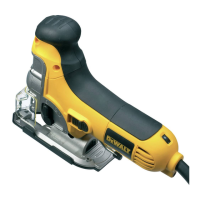11
ENGLISH
• To preset the sawing speed, turn the control dial
(3) to the desired level. The higher the rate, the
higher the sawing speed. The required setting
depends on the thickness and kind of material.
• Use high speeds for sawing soft materials such
as wood. Use low speeds for sawing metal.
DW333/DW333K (fig. G2)
The speed control dial (3) can be used for advance
setting of the required range of speed.
• Turn the electronic speed control dial to the
required level. The required setting depends on
the thickness and kind of material.
• Use high speeds for sawing soft materials such
as wood. Use low speeds for sawing metal.
After using the tool for an extended period
on low speed settings, run it for approx.
3 minutes on maximum no-load speed.
Sawing in wood
• If necessary, draw a cutting line.
• Switch the tool on.
• Hold the tool against the workpiece and follow
the line.
•
Sawing in wood using a pilot hole
• If necessary, draw a cutting line.
• Drill a hole (ø min. 12 mm) and introduce the saw
blade.
• Switch the tool on.
• Follow the line.
•
Sawing up to a projecting edge (fig. J)
• Using a conventional blade, cut up to the
projected edge.
• Finish off the cut using a flush cutting blade.
Dust extraction (fig. F)
• When the tool is used indoor for extended
periods of time, use a suitable dust extractor
designed in compliance with the applicable
Directives regarding dust emission.
Sawing in metal
• Mount an appropriate saw blade.
• Proceed as described above.
Use a cooling lubricant (cutting oil) to
prevent overheating of the saw blade or
the workpiece.
Maintenance
Your DEWALT power tool has been designed to
operate over a long period of time with a minimum
of maintenance. Continuous satisfactory operation
depends upon proper tool care and regular cleaning.
Lubricating the guide roller (fig. B)
• Apply a drop of oil to the guide roller (8) at regular
intervals to prevent jamming.
Cleaning
Keep the ventilation slots clear and regularly clean
the housing with a soft cloth.
For sawing parallel to the edge of your workpiece,
install the parallel fence (optional) and guide your
jigsaw along the workpiece a shown in figure H.
For cutting perfectly round shapes, install the
trammel bar (optional) and set it to the required
radius (fig. I).
Protecting the environment
Separate collection. This product must
not be disposed of with normal
household waste.
Should you find one day that your D
EWALT product
needs replacement, or if it is of no further use to you,
do not dispose of it with household waste. Make this
product available for separate collection.

